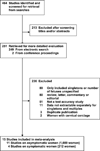Cervicovaginal fetal fibronectin for the prediction of spontaneous preterm birth in multiple pregnancies: a systematic review and meta-analysis
- PMID: 21067303
- PMCID: PMC3418880
- DOI: 10.3109/14767058.2010.499484
Cervicovaginal fetal fibronectin for the prediction of spontaneous preterm birth in multiple pregnancies: a systematic review and meta-analysis
Abstract
Objective: To investigate the accuracy of cervicovaginal fetal fibronectin in predicting preterm birth in women with multiple pregnancies.
Methods: Systematic review and meta-analysis of predictive test accuracy. Cohort or cross-sectional studies were identified through searches in databases, reference lists, proceedings, and reviews. Study selection, quality assessment, and data extraction were performed. We constructed summary receiver operating characteristic curves and calculated pooled sensitivities and specificities using a bivariate, random-effects meta-regression model. We also calculated summary likelihood ratios and post-test probabilities of preterm birth.
Results: Fifteen studies (11 in asymptomatic women and 4 in women with symptoms of preterm labor) involving 1221 women with multiple pregnancies were included. Among asymptomatic women with multiple or twin pregnancies, the pooled sensitivities, specificities, and positive and negative likelihood ratios for predicting preterm birth before 32, 34, and 37 weeks' gestation ranged from 33% to 45%, 80% to 94%, 2.0 to 5.5, and 0.68 to 0.76, respectively. Among women with twin pregnancies and threatened preterm labor, the test was most accurate in predicting spontaneous preterm birth within 7 days of testing (pooled sensitivity, specificity, and positive and negative likelihood ratios of 85%, 78%, 3.9, and 0.20, respectively).
Conclusions: Cervicovaginal fetal fibronectin provides moderate to minimal prediction of preterm birth in women with multiple pregnancies. The test is most accurate in predicting spontaneous preterm birth within 7 days of testing in women with twin pregnancies and threatened preterm labor.
Conflict of interest statement
Figures





Similar articles
-
Accuracy of cervicovaginal fetal fibronectin test in predicting risk of spontaneous preterm birth: systematic review.BMJ. 2002 Aug 10;325(7359):301. doi: 10.1136/bmj.325.7359.301. BMJ. 2002. PMID: 12169504 Free PMC article.
-
Fetal fibronectin testing for prevention of preterm birth in singleton pregnancies with threatened preterm labor: a systematic review and metaanalysis of randomized controlled trials.Am J Obstet Gynecol. 2016 Oct;215(4):431-8. doi: 10.1016/j.ajog.2016.04.038. Epub 2016 Apr 29. Am J Obstet Gynecol. 2016. PMID: 27133012
-
Cervical phosphorylated insulin-like growth factor binding protein-1 test for the prediction of preterm birth: a systematic review and metaanalysis.Am J Obstet Gynecol. 2016 Jan;214(1):57-73. doi: 10.1016/j.ajog.2015.06.060. Epub 2015 Jul 3. Am J Obstet Gynecol. 2016. PMID: 26149828 Free PMC article.
-
Predictive accuracy of changes in transvaginal sonographic cervical length over time for preterm birth: a systematic review and metaanalysis.Am J Obstet Gynecol. 2015 Dec;213(6):789-801. doi: 10.1016/j.ajog.2015.06.015. Epub 2015 Jun 10. Am J Obstet Gynecol. 2015. PMID: 26070703 Free PMC article.
-
Fetal fibronectin as a short-term predictor of preterm birth in symptomatic patients: a meta-analysis.Obstet Gynecol. 2009 Sep;114(3):631-640. doi: 10.1097/AOG.0b013e3181b47217. Obstet Gynecol. 2009. PMID: 19701045
Cited by
-
Endoscopic ultrasound elastography for differential diagnosis of pancreatic masses: a meta-analysis.Dig Dis Sci. 2013 Apr;58(4):1125-31. doi: 10.1007/s10620-012-2428-5. Epub 2013 Jan 10. Dig Dis Sci. 2013. PMID: 23306838
-
Prevention of preterm delivery: current challenges and future prospects.Int J Womens Health. 2016 Oct 31;8:633-645. doi: 10.2147/IJWH.S89317. eCollection 2016. Int J Womens Health. 2016. PMID: 27843353 Free PMC article. Review.
-
Neutrophil elastase and fetal fibronectin levels as predictors of single-birth prematurity.Exp Ther Med. 2015 Aug;10(2):665-670. doi: 10.3892/etm.2015.2508. Epub 2015 May 21. Exp Ther Med. 2015. PMID: 26622372 Free PMC article.
-
Cervical cerclage for prevention of preterm birth and adverse perinatal outcome in twin pregnancies with short cervical length or cervical dilatation: A systematic review and meta-analysis.PLoS Med. 2023 Aug 3;20(8):e1004266. doi: 10.1371/journal.pmed.1004266. eCollection 2023 Aug. PLoS Med. 2023. PMID: 37535682 Free PMC article.
-
Vaginal Progesterone Has No Diabetogenic Potential in Twin Pregnancies: A Retrospective Case-Control Study on 1686 Pregnancies.J Clin Med. 2020 Jul 15;9(7):2249. doi: 10.3390/jcm9072249. J Clin Med. 2020. PMID: 32679847 Free PMC article.
References
-
- Martin JA, Hamilton BE, Sutton PD, Ventura SJ, Menacker F, Kirmeyer S, Mathews TJ. National Vital Statistics reports. No 7. vol 57. Hyatsville, MD: National Center for Health Statistics; 2009. Births: final data for 2006.
-
- Ananth CV, Joseph KS, Oyelese Y, Demissie K, Vintzileos AM. Trends in preterm birth and perinatal mortality among singletons: United States, 1989 through 2000. Obstet Gynecol. 2005;105:1084–1091. - PubMed
-
- Reynolds MA, Schieve LA, Martin JA, Jeng G, Macaluso M. Trends in multiple births conceived using assisted reproductive technology, United States, 1997–2000. Pediatrics. 2003;111:1159–1162. - PubMed
-
- Chuileannáin FN, Brennecke S. Prediction of preterm labour in multiple pregnancies. Baillieres Clin Obstet Gynaecol. 1998;12:53–66. - PubMed
Publication types
MeSH terms
Substances
Grants and funding
LinkOut - more resources
Full Text Sources
Other Literature Sources
Medical
